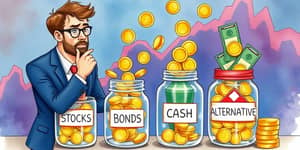
In an era defined by climate urgency and social responsibility, investors are seeking strategies that align financial goals with global impact. Sustainable investments have matured from niche portfolios into market leaders, offering both strong returns and tangible environmental and social benefits.
As of March 2025, global ESG fund assets stood at $3.16 trillion, demonstrating resilience despite recent outflows.
The US sustainable investment market encompasses over $8 trillion, representing about 12.5% of total investments.
In May 2025, assets of mutual funds and ETFs using ESG criteria increased by $24.89 billion to $571.81 billion, while environmental-focused funds grew 6.9% over the month.
Analysts project the total global market for ESG-related assets could exceed $40 trillion by 2030, driven by regulatory shifts and client demand.
Seventy-three percent of sustainable finance professionals expect significant market growth in the next two years, reflecting robust industry optimism.
Investor appetite for sustainability is at an all-time high across generations, regions, and asset classes.
Surveys show that 88% of global investors express interest in sustainable allocations, with 99% of Gen Z and 97% of Millennials keen to participate.
Motivations vary by region:
Globally, 59% plan to increase allocations in the next year, while only 3% intend to decrease exposure, signaling strong forward momentum.
The narrative of a trade-off between ethics and profitability is fading as sustainable funds outperform conventional peers.
In Q1 2025, global large-cap sustainable funds advanced 2.09%, outpacing broader market losses and highlighting resilience in turbulent conditions.
Multiple studies have linked higher ESG ratings with superior long-term returns, reduced volatility, and more efficient capital deployment strategies.
Today, more than half of investors believe that sustainable investments now offer returns comparable to, or better than, traditional assets, further boosting confidence and new capital inflows.
Climate change remains the dominant ESG theme, with strong alignment to SDGs such as Climate Action and Affordable Clean Energy driving global investment flows.
Stewardship and shareholder advocacy have also gained traction, covering 79% of US market assets through active engagement and proxy voting policies.
Governments and regulators are raising the bar on transparency and consistency in ESG disclosures.
New EU mandates, including biodiversity reporting under the TNFD, and global efforts toward harmonized frameworks are improving data quality and comparability.
Investors increasingly leverage AI-driven analytics and advanced impact assessment tools to navigate complex datasets and identify authentic sustainable opportunities.
The sustainable investing space faces headwinds such as political pushback and greenwashing allegations, alongside the persistent need for standardized, high-quality data.
Yet, opportunities abound in private equity, sustainability-linked bonds, and technology-driven sectors like green hydrogen and advanced battery storage.
By integrating rigorous stewardship and cutting-edge analytics, investors can mitigate risks, enhance transparency, and unlock value in emerging green asset classes.
Approximately $83 trillion is expected to transfer to younger generations over the next two decades, reshaping wealth management and investment priorities.
Gen Z and Millennials, armed with strong values alignment, are poised to allocate a larger share of this wealth into sustainable strategies.
This intergenerational shift underscores the importance of robust performance data, clear impact measurement, and personalized solutions that resonate with evolving investor values.
As markets evolve, sustainable investments can deliver financial returns and positive impact across diversified portfolios.
By embracing evidence-based strategies, staying informed on regulatory changes, and focusing on high-growth ESG themes, investors can build resilient, future-ready portfolios.
Now is the moment to add sustainable investments for both impact and returns, channeling capital toward a more equitable, prosperous, and sustainable world.
References













